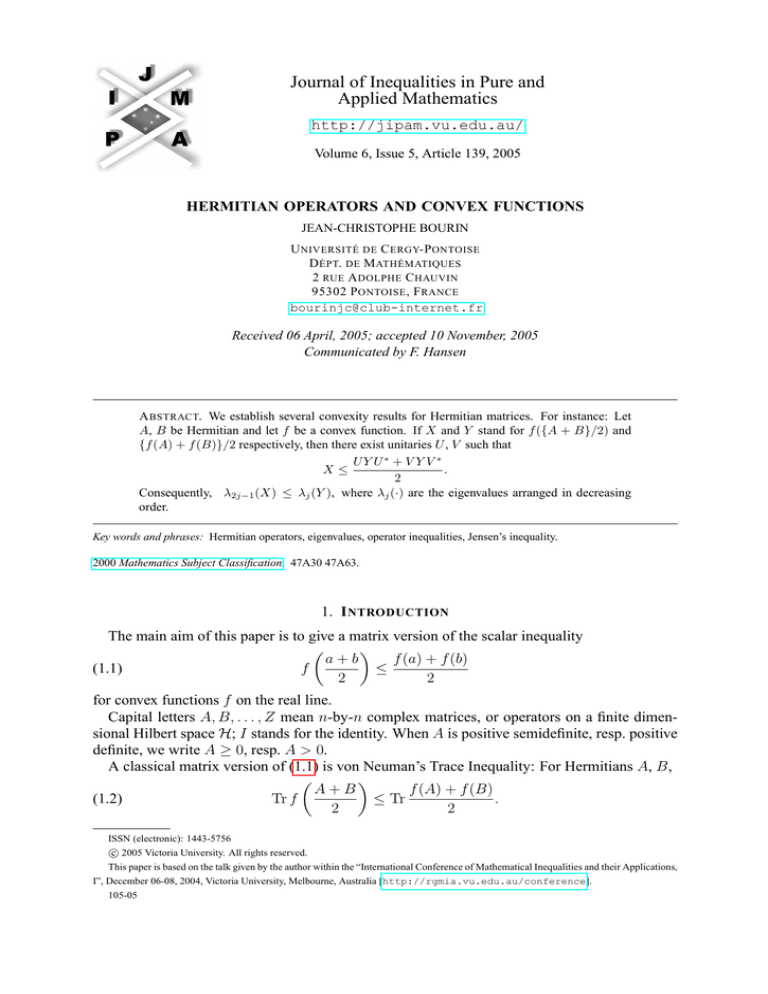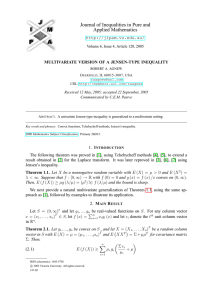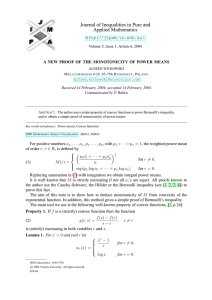
Journal of Inequalities in Pure and
Applied Mathematics
http://jipam.vu.edu.au/
Volume 6, Issue 5, Article 139, 2005
HERMITIAN OPERATORS AND CONVEX FUNCTIONS
JEAN-CHRISTOPHE BOURIN
U NIVERSITÉ DE C ERGY-P ONTOISE
D ÉPT. DE M ATHÉMATIQUES
2 RUE A DOLPHE C HAUVIN
95302 P ONTOISE , F RANCE
bourinjc@club-internet.fr
Received 06 April, 2005; accepted 10 November, 2005
Communicated by F. Hansen
A BSTRACT. We establish several convexity results for Hermitian matrices. For instance: Let
A, B be Hermitian and let f be a convex function. If X and Y stand for f ({A + B}/2) and
{f (A) + f (B)}/2 respectively, then there exist unitaries U , V such that
UY U∗ + V Y V ∗
X≤
.
2
Consequently, λ2j−1 (X) ≤ λj (Y ), where λj (·) are the eigenvalues arranged in decreasing
order.
Key words and phrases: Hermitian operators, eigenvalues, operator inequalities, Jensen’s inequality.
2000 Mathematics Subject Classification. 47A30 47A63.
1. I NTRODUCTION
The main aim of this paper is to give a matrix version of the scalar inequality
a+b
f (a) + f (b)
(1.1)
f
≤
2
2
for convex functions f on the real line.
Capital letters A, B, . . . , Z mean n-by-n complex matrices, or operators on a finite dimensional Hilbert space H; I stands for the identity. When A is positive semidefinite, resp. positive
definite, we write A ≥ 0, resp. A > 0.
A classical matrix version of (1.1) is von Neuman’s Trace Inequality: For Hermitians A, B,
A+B
f (A) + f (B)
(1.2)
Tr f
≤ Tr
.
2
2
ISSN (electronic): 1443-5756
c 2005 Victoria University. All rights reserved.
This paper is based on the talk given by the author within the “International Conference of Mathematical Inequalities and their Applications,
I”, December 06-08, 2004, Victoria University, Melbourne, Australia [http://rgmia.vu.edu.au/conference].
105-05
2
J EAN -C HRISTOPHE B OURIN
When f is convex and monotone, we showed [2] that (1.2) can be extended to an operator
inequality: There exists a unitary U such that
A+B
f (A) + f (B)
(1.3)
f
≤U·
· U ∗.
2
2
We also established similar inequalities involving more general convex combinations. These
inequalities are equivalent to an inequality for compressions. Recall that given an operator Z
and a subspace E with corresponding orthoprojection E, the compression of Z onto E, denoted
by ZE , is the restriction of EZ to E. Inequality (1.3) can be derived from: For every Hermitian
A, subspace E and monotone convex function f , there exists a unitary operator U on E such
that
f (AE ) ≤ U f (A)E U ∗ .
(1.4)
Inequalities (1.3) and (1.4) are equivalent to inequalities for eigenvalues. For instance (1.4) can
be rephrased as
λj (f (AE )) ≤ λj (f (A)E ), j = 1, 2, . . .
where λj (·), j = 1, 2, . . . are the eigenvalues arranged in decreasing order and counted with
their multiplicities. Having proved an inequality such as (1.3) for monotone convex functions,
it remains to search counterparts for general convex functions. We derived from (1.3) the following result for even convex functions f : Given Hermitians A, B, there exist unitaries U , V
such that
U f (A)U ∗ + V f (B)V ∗
A+B
≤
.
(1.5)
f
2
2
This generalizes a wellknown inequality for the absolute value,
|A + B| ≤ U |A|U ∗ + V |B|V ∗ .
We do not know whether (1.5) is valid for all convex functions.
In Section 2 we present a counterpart of (1.4) for all convex functions. This will enable us to
give, in Section 3, a quite natural counterpart of (1.3) for all convex functions. Although (1.3)
can be proven independently of (1.4) (and the same for the counterparts), we have a feeling that
in the case of general convex functions, the approach via compressions is more illuminating.
2. C OMPRESSIONS
Our substitute to (1.4) for general convex functions (on the real line) is:
Theorem 2.1. Let A be Hermitian, let E be a subspace and let f be a convex function. Then,
there exist unitaries U , V on E such that
f (AE ) ≤
U f (A)E U ∗ + V f (A)E V ∗
.
2
Consequently, for j = 1, 2, . . . ,
λ2j−1 (f (AE )) ≤ λj (f (A)E ).
Proof. We may find spectral subspaces E 0 and E 00 for AE and a real r such that
(i) E = E 0 ⊕ E 00 ,
(ii) the spectrum of AE 0 lies on (−∞, r] and the spectrum of AE 00 lies on [r, ∞),
(iii) f is monotone both on (−∞, r] and [r, ∞).
J. Inequal. Pure and Appl. Math., 6(5) Art. 139, 2005
http://jipam.vu.edu.au/
H ERMITIAN O PERATORS AND C ONVEX F UNCTIONS
3
Let k be an integer, 1 ≤ k ≤ dim E 0 . There exists a spectral subspace F ⊂ E 0 for AE 0 (hence
for f (AE 0 )), dim F = k, such that
λk [f (AE 0 )] =
min
h∈F ; khk=1
hh, f (AF )hi
= min{f (λ1 (AF )) ; f (λk (AF ))}
=
=
min
f (hh, AF hi)
min
f (hh, Ahi),
h∈F ; khk=1
h∈F ; khk=1
where at the second and third steps we use the monotonicity of f on (−∞, r] and the fact that
AF ’s spectrum lies on (−∞, r]. The convexity of f implies
f (hh, Ahi) ≤ hh, f (A)hi
for all normalized vectors h. Therefore, by the minmax principle,
λk [f (AE 0 )] ≤
min
h∈F ; khk=1
hh, f (A)hi
≤ λk [f (A)E 0 ].
This statement is equivalent to the existence of a unitary operator U0 on E 0 such that
f (AE 0 ) ≤ U0 f (A)E 0 U0∗ .
Similarly we get a unitary V0 on E 00 such that
f (AE 00 ) ≤ V0 f (A)E 00 V0∗ .
Thus we have
f (AE ) ≤
U0 0
0 V0
∗
f (A)E 0
0
U0 0
.
0 V0∗
0
f (A)E 00
Also, we note that, still in respect with the decomposition E = E 0 ⊕ E 00 ,
1
I 0
I 0
I 0
I 0
f (A)E 0
0
f (A)E
+
f (A)E
.
=
0
f (A)E 00
0 I
0 I
0 −I
0 −I
2
So, letting
U=
U0 0
0 V0
and V =
U0
0
0 −V0
we get
(2.1)
f (AE ) ≤
U f (A)E U ∗ + V f (A)E V ∗
.
2
It remains to check that (2.1) entails
λ2j−1 (f (AE )) ≤ λj (f (A)E ).
This follows from the forthcoming elementary observation.
Proposition 2.2. Let X, Y be Hermitians such that
UY U∗ + V Y V ∗
2
for some unitaries U , V . Then, for j = 1, 2, . . . ,
(2.2)
X≤
λ2j−1 (X) ≤ λj (Y ).
J. Inequal. Pure and Appl. Math., 6(5) Art. 139, 2005
http://jipam.vu.edu.au/
4
J EAN -C HRISTOPHE B OURIN
Proof. By adding a rI term, for a suitable scalar r, both to X and Y , it suffices to show that
(2.3)
λ2j−1 (X) > 0
=⇒
λj (Y ) > 0.
We need the following obvious fact: Given Hermitians A, B,
rank(A + B)+ ≤ rankA+ + rankB+
where the subscript + stands for positive parts. Applying this to A = U Y U ∗ and B = V Y V ∗
we infer that the negation of (2.3), that is λ2j−1 (A + B) > 0 and λj (A) (= λj (B)) ≤ 0, cannot
hold. Indeed, the relation
2j − 1 > (j − 1) + (j − 1)
would contradict the previous rank inequality.
Remark 2.3. From inequality (2.2) one also derives, as a straightforward consequence of Fan’s
Maximum Principle [1, Chapter 4],
k
X
λj (X) ≤
j=1
k
X
λj (Y )
j=1
for k = 1, 2, . . . .
Inequality (2.2) also implies
1
λi+j+1 (X) ≤ {λi+1 (Y ) + λj+1 (Y )}
2
for i, j = 0, 1, . . . . It is a special case of Weyl’s inequalities [1, Chapter 3].
Remark 2.4. For operators acting on an infinite dimensional (separable) space, the main inequality of Theorem 2.1 is still valid at the cost of an additional rI term in the RHS, with r > 0
arbitrarily small. See [3, Chapter 1] for the analogous result for (1.4).
Obviously, for a concave function f , the main inequality of Theorem 2.1 is reversed. But the
following is open:
Problem 1. Let g be a concave function, let A be Hermitian and let E be a subspace. Can we
find unitaries U , V on E such that
g(A)E ≤
U g(AE )U ∗ + V g(AE )V ∗
?
2
3. C ONVEX C OMBINATIONS
The next two theorems can be regarded as matrix versions of Jensen’s inequality. The first
one is also a matrix version of the elementary scalar inequality
f (za) ≤ zf (a)
for convex functions f with f (0) ≤ 0 and scalars a and z with 0 < z < 1.
Theorem 3.1. Let f be a convex function, let A be Hermitian, let Z be a contraction and set
X = f (Z ∗ AZ) and Y = Z ∗ f (A)Z. Then, there exist unitaries U , V such that
UY U∗ + V Y V ∗
.
2
Pm ∗
A family {Zi }m
i=1 is an isometric column if
i=1 Zi Zi = I.
X≤
J. Inequal. Pure and Appl. Math., 6(5) Art. 139, 2005
http://jipam.vu.edu.au/
H ERMITIAN O PERATORS AND C ONVEX F UNCTIONS
5
m
m
Theorem 3.2. Let f be aP
convex function, let {AP
i }i=1 be Hermitians, let {Zi }i=1 be an isometric
column and set X = f ( Zi∗ Ai Zi ) and Y =
Zi∗ f (Ai )Zi . Then, there exist unitaries U , V
such that
UY U∗ + V Y V ∗
.
X≤
2
Corollary 3.3. Let f be a convex function, let A, B be Hermitians and set X = f ({A + B}/2)
and Y = {f (A) + f (B)}/2. Then, there exist unitaries U , V such that
UY U∗ + V Y V ∗
.
2
Recall that the above inequality entails that for j = 1, 2, . . . ,
X≤
λ2j−1 (X) ≤ λj (Y ).
We turn to the proof of Theorems 3.1 and 3.2.
Proof. Theorem 3.1 and Theorem 2.1 are equivalent. Indeed, to prove Theorem 2.1, we may
assume that f (0) = 0. Then, Theorem 2.1 follows from Theorem 3.1 by taking Z as the
projection onto E.
Theorem 2.1 entails Theorem 3.1: to see that, we introduce the partial isometry J and the
operator à on H ⊕ H defined by
Z
0
A 0
J=
, Ã =
.
0 0
(I − |Z|2 )1/2 0
Denoting by H the first summand of the direct sum H ⊕ H, we observe that
f (Z ∗ AZ) = f (J ∗ ÃJ) : H = J ∗ f (ÃJ(H) )J : H,
where X : H means the restriction of an operator X to the first summand of H ⊕ H. Applying
Theorem 2.1 with E = J(H), we get unitaries U0 , V0 on J(H) such that
U0 f (Ã)J(H) U0∗ + V0 f (Ã)J(H) V0∗
J : H.
2
Equivalently, there exist unitaries U , V on H such that
f (Z ∗ AZ) ≤ J ∗
U J ∗ f (Ã)J(H) (J : H)U ∗ + V J ∗ f (Ã)J(H) (J : H)V ∗
f (Z AZ) ≤
2
1
f
(A)
0
0
∗
∗
∗ f (A)
∗
=
UJ
(J : H)U + V J
(J : H)V
0
f (0)
0
f (0)
2
1
= U {Z ∗ f (A)Z + (I − |Z|2 )1/2 f (0)(I − |Z|2 )1/2 }U ∗
2
1
+ V {Z ∗ f (A)Z + (I − |Z|2 )1/2 f (0)(I − |Z|2 )1/2 }V ∗ .
2
Using f (0) ≤ 0 we obtain the first claim of Theorem 3.2.
Similarly, Theorem 2.1 implies Theorem 3.2 (we may assume f (0) = 0) by considering the
partial isometry and the operator on ⊕m H,
Z1 0 · · · 0
A1
.. ,
...
... ...
.
.
Zm 0 · · · 0
Am
∗
J. Inequal. Pure and Appl. Math., 6(5) Art. 139, 2005
http://jipam.vu.edu.au/
6
J EAN -C HRISTOPHE B OURIN
We note that our theorems contain two well-known trace inequalities [4], [5]:
3.4. Brown-Kosaki: Let f be convex with f (0) ≤ 0 and let A be Hermitian. Then, for all
contractions Z,
Tr f (Z ∗ AZ) ≤ Tr Z ∗ f (A)Z.
3.5. Hansen-Pedersen: Let f be convex and let {Ai }m
i=1 be Hermitians. Then, for all isometric
column {Zi }m
,
i=1
!
X
X
Tr f
Zi∗ Ai Zi ≤ Tr
Zi∗ f (Ai )Zi .
i
i
R EFERENCES
[1] R. BHATIA, Matrix Analysis, Springer, Germany, 1996.
[2] J.-C. BOURIN, Convexity or concavity inequalities for Hermitian operators, Math. Ineq. Appl., 7(4)
(2004), 607–620.
[3] J.-C. BOURIN, Compressions, Dilations and Matrix Inequalities, RGMIA monograph, Victoria
university, Melbourne 2004 (http://rgmia.vu.edu.au/monograph)
[4] L.G. BROWN AND H. KOSAKI, Jensen’s inequality in semi-finite von Neuman algebras, J. Operator Theory, 23 (1990), 3–19.
[5] F. HANSEN AND G.K. PEDERSEN, Jensen’s operator inequality, Bull. London Math. Soc., 35
(2003), 553–564.
J. Inequal. Pure and Appl. Math., 6(5) Art. 139, 2005
http://jipam.vu.edu.au/






